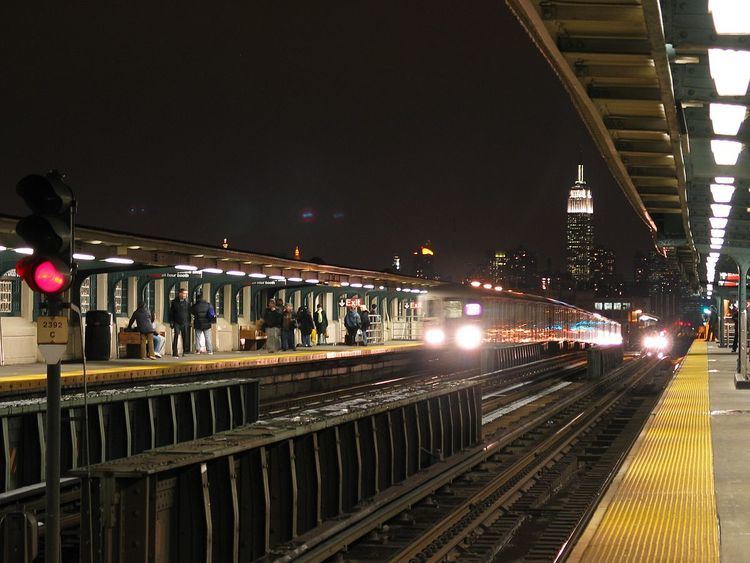Division A (IRT) Services 7 (all times) Platforms 2 side platforms Borough Queens Tracks 3 | Line IRT Flushing Line Structure Elevated Opened 21 April 1917 Locale Sunnyside | |
 | ||
Transit connections NYCT Bus: Q32, B24
MTA Bus: Q60, Q104 Address Queens, NY 11104, United States Similar 40th Street–Lowery Street, 33rd Street–Rawson Street, 52nd Street, 69th Street, Hunters Point Avenue | ||
46th Street–Bliss Street is a local station on the IRT Flushing Line of the New York City Subway. Located at the intersection of 46th Street and Queens Boulevard in Sunnyside, Queens, it is served by the 7 train at all times.
Contents
History
The Flushing Line was opened from Queensboro Plaza to 103rd Street – Corona Plaza on April 21, 1917, with a local station at 46th Street.
The platforms at 46th Street were extended in 1955–1956 to accommodate 11-car trains.
Station layout
This elevated station has three tracks and two side platforms. The center track is used by the rush hour peak direction <7> express train. This is the easternmost (railroad north) station on the IRT Flushing Line's concrete viaduct above Queens Boulevard. East of here, the line curves north and becomes elevated over Roosevelt Avenue.
Each platform has concrete windscreens painted in beige and green canopies in the center and waist-high beige barriers at either side. The windscreens contain stained glass windows as part of an artwork called "Q is For Queens" by Yumi Heo installed in 1999. They depict various images related to Heo's children book illustrations. This can also be found on the station's main entrance.
Exits
This station has two entrances/exits, both of which are station houses built within the viaduct's concrete structure. The main one is at the west (geographic south) end of the station and has two staircases and one turnstile bank to each platform, token booth, and four street stairs built within the viaduct's support pillars. These stairs lead to all four corners of 46th Street and the parking lot underneath the viaduct and between the two sides of Queens Boulevard. This entrance does not allow a free transfer between directions (even though it has the layout that could allow one as both turnstile banks lead to the center of the station house).
The station's other entrance is unstaffed, containing just HEET and exit-only turnstiles, two staircases to each platform, and two street stairs, also built within the support pillars, going down to either western corners of 47th Street and the parking lot. This entrance has a waiting area that allows a free transfer between directions.
Naming
46th Street was originally named simply Bliss Street after early ferry operator and industrialist Neziah Bliss, whose other namesakes include the nearby neighborhood of Blissville. His name was dropped from the street in the 1920s. The subway station retained the name until 1998, during which time the station name was the inspiration for the electronic band 46bliss. In 1998, the MTA removed it from maps and signage, but by 2003, neighborhood activist Pat Dorfman collected 1,900 signatures, successfully lobbying the MTA and the City Council to restore the old street and station names. The MTA did so in 2004, and the Council added the ceremonial name; street intersection signs near the station now feature a secondary Bliss St plaque.
